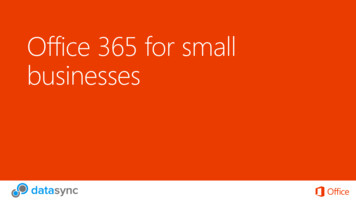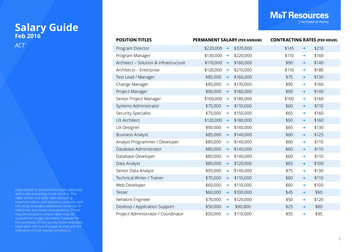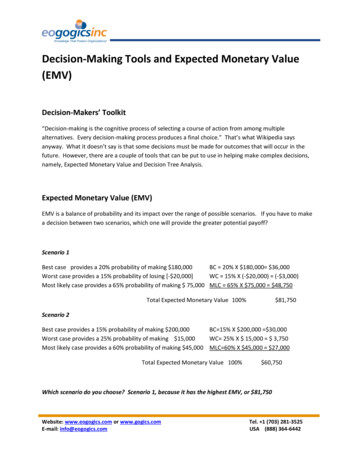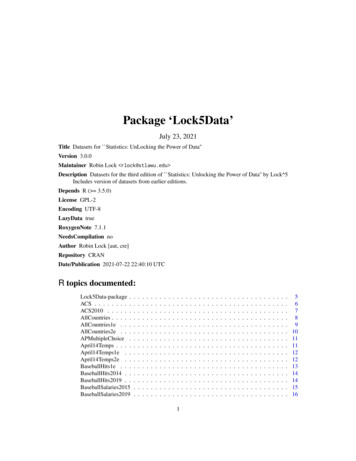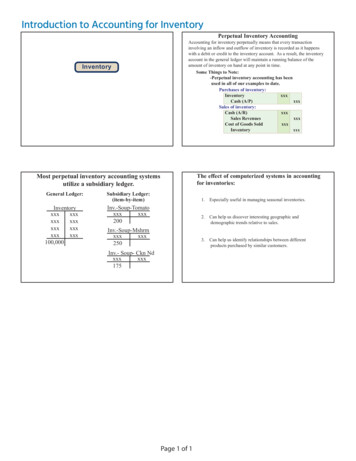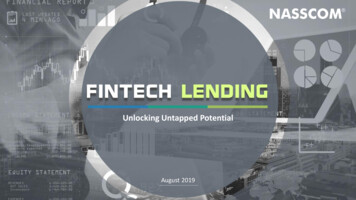
Transcription
Unlocking Untapped PotentialAugust 2019
Foreword2The NASSCOM Research report titled “Fintech Lending – Unlocking Untapped Potential” aims to highlight the evolving trends in the field of Fintech Lendingand intricacies involved in this business.This study includes in-depth primary research and covers market opportunities, competitive trends, success factors, key business models, and growth stories.We hope you find this study useful, and we welcome your feedback and comments.Debjani GhoshPresident, NASSCOMAcknowledgementNASSCOMAshish GuptaManager - ResearchNASSCOMKomal GuptaAnalyst - PolicyThis report on the Fintech Lending market in India has been developed by NASSCOM through a comprehensive research process.The preparation of this report has been made possible with information from various sources and assistance from institutions, enterprises, andstart-ups in India who have given their time and insights to the research team. We wish to sincerely thank all of them for their valuable contributionswithout which this report would not have been possible.2
TABLE OF CONTENTS5Executive Summary8India Fintech Overview11Fintech Lending Market Overview15Fintech Lending Trends24Fintech Lending Business Opportunities30Key Risks and Challenges32NASSCOM Recommendations34Fintech Lending 2020 Outlook3
Research Methodology5The Fintech Lending- Unlocking Untapped Potential Report isa comprehensive study based on in-depth interviews withNASSCOM members that include large and small technologyfirms, proprietary startup database, and key governmentstakeholders, supported by comprehensive secondaryresearch.CaseStudiesPublic SourcesPrimary research has been the major contributor to thefindings and recommendations of the report. We conductedmultiple interviews over a span of 4 months with key industrystakeholders to develop an understanding around the themescovered in the report. Policy thinkers and data experts havealso provided their inputs to enable us to present a holisticview on the rapidly transforming industry.As part of the secondary research process, we looked atorganization and industry reports, public statements, mediaarticles, government releases, national and global databasesand previous NASSCOM reports on Fintech startups.Expert Interviews4
Executive Summary6IntroductionOver the last decade, India has emerged as a Fintech industry leader. This can belargely be attributed to the government initiatives that have led to greaterinvestment opportunities in this sector while encouraging the consumers to shiftto adoption of Fintech based products and services. Research indicates that at87%, India has the highest Fintech adoption rate in the world, and is home to the2nd largest Fintech start-up base in the world. Our research shows that digitallending, digital payments and wealth management are the three segments underFintech where most of the start-ups are concentrated in India.This report focuses entirely on Fintech lending segment under the broaderFintech umbrella. We have traced the evolution of Fintech Lending industry inIndia while highlighting the key drivers for growth, trends, challenges andopportunities. The report also highlights new business opportunities and keysuccess factors for the Fintech lending industry in India, in addition to identifyingbottlenecks faced by the industry, and recommend action steps to unlock theuntapped potential of the industry.Market OverviewThe Fintech lending industry can be broadly classified under three major segmentsSME lending, Consumer Lending and Online Lending Platforms. While start-ups startedentering into this industry 2013 onwards largely to capture the untapped credit market,large tech companies seem to have recently targeted this segment. Credit demandfrom MSME and consumers presents an addressable opportunity of USD 1 trillion by2023.Most of these big tech companies, which have already been operating in othersegments such as e-commerce, digital payments etc. have large consumer base, andrelated consumer data. By applying advanced data analytics, these companies havedeveloped deep insights on consumer spending patterns. This has enabled them tocome up with their own credit score of consumers based on recent bank history,repayment trends and other similar attributes. These companies are generally offeringloan products as an add-on facility for consumers.5
Executive Summary6Market TrendsStart-ups, non-banking financial companies (NBFCs) and large tech companiesare competing against each other to capture a bigger market share. Whilestart-ups have relatively lesser access to capital, they possess strong dataanalytics capabilities. Major Fintech companies such as Google Pay, Ola,Amazon, Truecaller, among others, have started entering into the lendingbusiness as a part of their expansion strategy. The major drivers include, easymarket entry and targeted loan offerings due to large customer data insights,better margins than other Fintech business models such as payments andfinancial services, and prevalence of huge untapped market for unsecuredloans.While we have observed that each of the three types of competitors i.e. startups, NBFCs and large tech companies, have their own strengths, the Fintechlending industry at large benefits from partnership models. Fintechcompanies collaborating with established NBFCs or banks can reduce marketentry time by 50% as compared to applying for its own NBFC license to enterthe market. In addition, collaborating with NBFCs enables both partners tolaunch combine product based on customer portfolio. Strong data analytics,effective partnerships and low default rates are key success factors in thisbusiness.Key FindingsBusiness OpportunitiesThe major business opportunities prevailing in the Fintech lending industry are Point-of-sale (POS) based lending which provides easy access to merchant related datawhich allows easy credit check. Peer-to-peer (P2P) based lending allows individuals to lend to another individual. Invoice based lending aims at financing merchants against the amount due fromcustomer i.e. account receivables Short term lending gives users credit in customized manner, which allows them to makeinstant purchases. The ‘buy now, pay later’ model based on a similar concept is beingadopted by companies to target a new set of customers. Even as new business modelsare being used to penetrate the market, increasing credit demand from consumers andMSME offers an addressable opportunity in the coming years.5
Executive Summary6Key Risks and ChallengesThe following risks/ challenges with Fintech lending have been identified Liquidity squeeze can cause interest rates to rise directly impacting endcustomers. Business viability is questionable as default rate increases There are no clear guidelines for first loan default guarantee, which canprovide safety to lenders. Bad loan ratio of NBFCs have almost doubled in last 5 years. Borrowed money from NBFCs and banks for lending comes with a highinterest rate. RBI lending regulations such as P2P lending law which caps maximumlending or borrowing by a single vendor to USD 0.014 mn (INR 10 lakhs) Talent is a challenge for Fintech lending companies.RecommendationsThe report lists out a four-fold action agenda to be implemented by the government,industry and NASSCOM. These include, addressing ease of digital on-boarding ofcustomers, reducing default rates, improving access to credit, and supporting newtechnology and innovation in lending.Outlook for 2020NASSCOM Research expects the following trends in Fintech lending in India in thefuture More focus on data analytics for more accurate credit scores. More collaboration among Fintech start-ups, banks and NBFCs. Emergence of customized solutions like credit cards and accounts based onborrower’s credit profile. Allowing portability of trusted data between service providers under DataEmpowerment and Protection Architecture (DEPA) architecture. Lending companies to have in-house capability of offering loans, compliance,regulatory etc.5
INDIA FINTECHOVERVIEW8
India Has Emerged As A Fintech Industry LeaderHighest Adoption Rate in the WorldIndia87%2nd largest Fintech Start-up Base in the World1500 1100 Global64%USAFintech Adoption Index 2019Rapid Growth in TransactionsCAGR22%No. of Fintech Startups Founded (2015-18)Fintech Software Market73CAGR 19%2.41.2332016India2020Fintech Transaction Value (in USD bn)Source: EY Global Fintech Adoption Index 2019 , Yes Bank Report, Tracxn20162020Fintech Software Market in India (in USD bn)9
Diverse Fintech Landscape in IndiaDIGITAL LENDING 330 Start-upsDigital Lending allow access to loan throughdigital mean and with minimal paperworkSource: News Articles, Tracxn, NASSCOMDIGITAL PAYMENTS 370 Start-upsDigital Payments allows making paymentsthrough digital instrumentsIllustrative List of Start-upsWEALTH MANAGEMENT 300 Start-upsDigital Wealth Management offers tools,platforms for investments advisory10
FINTECH LENDINGMARKET OVERVIEW11
Rapidly Growing Fintech Lending Landscape in IndiaSME LendingProviding fast credit to small and medium enterprises through digital platformConsumer LendingOnline Lending PlatformsProviding credit to individual consumers through digital platformProvides a marketplace where individual consumers can connectwith bank or lenders through online portalsSource: News Articles, Tracxn, NASSCOM12
Lending Business Evolution: Industry at Inflection PointEntry of Large Tech CompaniesFintech Lending EraLarge companies which are into thebusiness of e-commerce, payments etc.started entering into this market300No. of Start-upsRapid Business Growth forStartupsAlternative lending funding increasedfrom just USD 21 mn to USD 537 mn in2018200Entry of Lending Start-ups100Tech start-ups found lending business to beattractive due to large untapped market502000Source: News Articles, Tracxn, NASSCOM20132015201713
Fundamental Lending Challenges In India Translating To Massive FintechLending OpportunitiesAddressable OpportunityLow Penetration of Traditional Financial Instruments ATM penetration rates 0.5X global average Credit card penetration at 0.01X in India compared to USAUnmet Needs Household to debt ratio 0.1X of global average 300 million Unbanked households looking for credit access MSME unmet credit gap expected to reach USD 900 bn by 2023Banking Sector Challenges As of March 2019, Indian banks NPA stands at USD 135 bn 6 public sector banks are still under prompt corrective action due to risingNPA and facing restriction on lendingCAGR: 6% USD 900 bn USD 640 bn20172023MSME Credit DemandCAGR: 36% USD 350 bn USD 75 bnTraditional Customer Evaluation Methodology Physical, time-consuming and non analytics based background verification Collateral based lendingSource: News Articles, MSME, Tracxn, NASSCOM20182023India Digital Lending Market14
FINTECH LENDINGTRENDS15
Lending Market Attractiveness- Better Data Better Analysis BetterMarginsBetter MarginsHigh Volume Market2Lending can offer better margins compared to otherFintech business models like payments, financial servicesetc.13Customer Data Enabling Market EntryLarge companies are sitting on huge volumes ofcustomer data making it easier for them to enterAdvancement in Data ScienceRapid growth in big data and analytics tools andtechnologies in addition to availability of quality analyticstalent driving the marketHuge untapped market of unsecured loansTransactional DataBusiness transaction data help companies to understandthe needs and offer them targeted and customised loans4Relative Lack of CompetitionLending business offers large untapped customer baseoffering substantial growth opportunitiesCOMPANIES ENTERING LENDING BUSINESS AS A FINTECH BUSINESS EXPANSIONIllustrative ListSource: News Articles, Tracxn, NASSCOM16
Start-ups, Large Tech Companies And NBFCs Are Key CompetitorsAccess to CapitalCustomer DataAnalyticsRiskStart-ups Aggressive business strategy Strong data analytics capabilities Partnership drivenLarge tech CompaniesNBFC / MicrofinanceLowSource: News Articles, NASSCOMMedium Aggressive business strategy Strong data analytics capabilities Huge customer traction in limited time Huge customer base Established brands Distribution and reachHigh15
Lending Success Factors- Establishing Partnerships for Market Access,Using Data to lower Default RatesAccess to the merchant / individual data can helpcreate a credible credit score. Fintech companiesneed to partner with e-commerce companies likeSwiggy, Amazon etc. to get such dataKeeping the default rate low is the prime focus ofevery lending firm as it directly impacts themargin and business sustainabilityPartnerships help in driving mutual growth asboth Fintech firms and banks / NBFCs havethere own strength and weaknessesSource: News Articles, NASSCOM18
A Partnership Approach Can Reduce Market Entry Time by 50%Illustrative TimelineGetting own NBFC LicenseUse Case:To expand in Tier 2 To loan vehicles and To offer OLA creditand Tier 3 citiesfinance dealers(pay later product)Feasibility Check / LaunchPilot ProjectIdeationApply for NBFC LicenseNBFC License receivedCombining Data and TechnologyRequirement of minimum netowned fund of ÙSD 0.29 mn(INR 2 crore)Lending from own balance sheetcan start after receiving thelicenseTo offer creditand insurance toconsumers andsellersTo offer creditand insurance toconsumers andsellersTo offer consumerloans for electronics,home appliances etc.Working with an established partnerUse Case:Feasibility Check / LaunchPilot ProjectIdeationLooking for the relevantpartnerCombining Data and A Bank or NBFC should beTechnologyapproached for partneringSource: News Articles, NASSCOMOffering a Money tapRBL Credit CardProduct LaunchTo lend capital toconsumers andapplicantsBoth partners to launchcombine product based oncustomer portfolio6 months12 months17
Case Studies- Partnerships and Default RateNelito has partnered with Sonata Finance (a USD 212bnworth of asset based NBFC providing microfinance loansTo address challenges in typical loan issuance process, over an year wasspent to deliver tailor made solutions for Sonata finance: Business Correspondent ManagementLow Default RateInstamojo offers byte-sized loans to help smallbusinesses manage your cash flow and working capitalrequirements. Securitization Loan Management Repayment module of securitized loanLending Default Rate: 0.01% Funder Repayment Pledge, unpledged FD managementPartnershipSuch a low default rate requires strongbackground analytics: Strong KYC approval process Weeding out fraudulent merchants Using computer vision algorithm for patterndetection and document authenticity Use of Natural Language Processing Algorithms tofigure out merchant business20
Data is the Holy Grail in Fintech LendingIllustrative Data SourcesOnline Spending DataPurchases and selling on onlineplatforms like Amazon, Flipkart etc.Avg. online retail spending at USD224 per online buyerSMS DataSMS has all kind ofinformation like credit, debitin the accounts210 billion messagestravelled in 2018Credit Bureau DataBureaus Provides credit score ofindividuals by looking atindividuals repayment behaviourRisk TierBorrowerPrime Plus801-900Prime751-800Near Prime651-750Subprime300-650Point of Sale DataTransactional data on POSwhere customer executepayment of goods or service400 million monthly debit cardstransactions at POS terminalsSource: News Articles, NASSCOMSocial Media ActivityData on google maps, payments tocabs, bill payments etc.Almost 40% of daily media timepeople spend on digital media21
Cross-Referencing Multiple Credit Data Points Can Significantly ReduceDefault RatesSMEs and Individual credibility check requires referring to multiple sources to create a credible credit scoreApp Based Data Bank DataExpense tracker apps (like Walnut,FinArt, MoneyView, Beewise etc.) Business DataE-commerce DataPromotors InfoVolume of BusinessGeographical distribution of businessBusiness AgingEnd Consumer of BusinessBalance Sheet Data Source: News Articles, NASSCOMPast Lending BehaviourDebit / Credit DataCash FlowGoods & Service Tax Data Merchants sales data information Value, number, frequency of e-moneyaccount credit / debitProper Credibility Checks canreduce default rates by 1-2 %22
Case Studies- Data Analytics and Cost ReductionFlexiLoans is an online lending platform started with an endeavor to solve theproblem that SMEs face in accessing quick, flexible and adequate funds forgrowing their businesses. Step 1 - Customer Acquisition”: Dynamic prioritization of leadsthat leads to 50% faster onboarding and have 7 interfaces forcustomer acquisition Step 2 - Application Processing: Have an Image Classifier thatreduces pre-processing time by 98%. They also extract publiclyavailable 3,000 data points to better assess customers. Step 3 - Credit Appraisal: FlexiLoans has a suite of credit scoringmodels that generate proprietary scores Step 4 - Collections: Flexiloans has 1) integrated early warningsystem, 2) collection analytics that are looped into assessmentand 3) deep integration with banks that helps in auto-escrowdeductions & one-click disbursements.Data AnalyticsBorrowing CostReductionBharatPe is a payments company serving theoffline retailers and businesses empoweringmerchants to accept UPI payments for ‘FREE’through the BharatPe QR BharatPe focus on creating a good book with risk &collections first approach which helps weed out thepotential bad customers and hence build a profitablebook with low NPAs . This in turn helped them to getmaximum return on our equity and negotiate abetter borrowing cost with our lenders.23
FINTECH LENDINGBUSINESSOPPORTUNITIES24
POS Based Lending Is The Fastest Growing Lending Solution SegmentPoint of Sale based LendingIt aims at financing merchants who use swiping machine for payment acceptanceTarget SegmentBusiness HighlightsPOS based lending provide easy access tomerchant related data which allows easycredit check. Data parameters provided byPOS are: Merchant Profiles: category,business address etc.Key Players Key Data Sets for CredibilityCheck Swipe Machine Transaction Data Sellers Data on e-commerceplatform like Amazon, Flipkart etc.Transaction Data: Time, date,debit/credit of transaction724CAGR11%23620162022India POS Terminal Market (in USDmn)Post business Data: tracking thehealth of the business POS market expected to grow at 11% till 2022 due to digitization focus Source: News Articles, NASSCOMMarket NumbersPOS industry in India can reach valuation of USD 3 bn by 202423
P2P Lending Driving Consumer Based Lending in IndiaP2P LendingIt links unsecured personal loan borrows to the investors who want to earn higher interestTarget SegmentBusiness HighlightsP2P based lending is the consumertype of lending allowing anindividual to lend to anotherindividual. It has certain benefits:Key Data Sets for CredibilityCheck Credit Bureau DataExpense Tracker AppsMarket Numbers4000CAGR 100%LenderKey Players Borrower Source: News Articles, NASSCOMBetter Returns: Up to30%Monthly payment withinterestWith no credit historyonce can ask for loanPaperless application2920162022India P2P Market (in USD mn) P2P lending market is expected to reach USD 4-5 billion by 2023. Only 30 players in market have RBI licenses for executing P2P business.24
Invoice Based Lending Providing Support to Many MSMEsInvoice based LendingIt aims at financing merchants against the amount due from customer which is basically accountreceivablesTarget SegmentKey PlayersBusiness Highlights Credit history of the merchantcan be checked whose invoiceneeds to be discounted NBFC credit squeeze have adirect impact on invoice basedlending due to shortage ofworking capitalKey Data Sets for CredibilityCheck Market Numbers63CAGR 20%POS Terminal DataBank Transaction DataMerchant transaction data from ecommerce132007-082015-16Number of MSMEs in India (in mn) Source: News Articles, NASSCOMHigh growth in number of SMEs in past 10 yearsSMEs are discounting bills worth more than USD 140 mn every monthMandatory for companies with turnover USD 70 mn to be part of TReDS (TradeReceivables Electronic Discount System)25
Short Term Lending is Gaining Momentum Due to Instant Credit NeedShort Term LendingIt gives users credit in customized manner which allows them to make instant purchasesBusiness HighlightsTarget Segment Offer flow of money in theform of flexi EMIs Most of short term loans aredispersed in hours or within aday or two.Key Data Sets for CredibilityCheck Credit Bureau DataExpense Tracker AppsBank Transaction DataMarket Numbers144CAGR 10%88Key Players20152018Credit under the personal finance segment(in USD bn) Source: News Articles, NASSCOMCredit under the personal finance segment at USD 144 bnCatering to wide market like salaried individuals, college students etc.26
Case Studies- Buy Now, Pay LaterePayLater is a digital payment solution that enables a "Buy Now,Pay Later" solution for frequent online purchasersOne can start transacting with this digital credit across categories such astravel, movies, food, retail, groceries and more. It allows the users a 14-dayinterest-free period from the date of purchase to settle the payment. It also offers UPI powered credit solution. The recent launch ofePayLater UPI enables the users to transact on top merchantportals that are UPI enabled. It has an in-app OTP option for IRCTC users to process fastertatkal bookings.Innovative Business ModelInnovative Business ModelLazypay is the product of PayU (a fintech companythat provides payment technology to onlinemerchants introduced a lending product). Lazypayworks on the principle of “Buy Now Pay Later” whichaddresses short-term credit needs of consumers fortheir purchases Users need to check their unique credit limit byentering personal and KYC details about themselves. The customers can shop online across 100 merchants and choose the option to pay later atcheckout. All purchases are consolidated into a LazyPay bill,due on 3rd and 18th of each month. The apps sends regular reminders to its users tomake quick repayments and tracks spending. Partners: Swiggy, BookMyShow, Croma amongothers29
KEY RISKS ANDCHALLENGES30
Risks / Challenges with Fintech LendingLiquidity SqueezeLiquidity squeeze can cause interestrates to rise directly impacting endcustomersSkill DeficitDefault RateFintech lending companies struggle to getskilled professionalsBusiness viability is questionable asdefault rate increases ( 6%)Funds / PartnershipsCredit LimitPartnering with Banks or NBFCs a catalyst forFintech companiesRBI lending regulations such as P2P lending lawwhich caps maximum lending or borrowing bya single vendor to USD 0.014 mn (INR 10 lakhs)First Loss Default Guarantee (FDLG)Borrowing CostBorrowed money from NBFCs and banksfor lending comes with a high interest rateNo clear guidelines for first loan default guaranteewhich can provide safety to lendersBad LoansSource: News Articles, NASSCOMBad loan ratio of NBFCs climbed to 6.6%from 3.6% in past 5-6 years31
NASSCOMRECOMMENDATIONS32
NASSCOM RecommendationsAddress issues pertaining to digital on-boarding of customers Modifying MoF circular for the use of Aadhaarauthentication services by non-banking entitiesSupport new technology and innovation in lending Allowing lending companies to directly approachUIDAI for e-KYC authentication facility RBI has excluded innovations pertaining to creditEncourage lendinginformation and credit registry, from the sandbox,products/services/technologythis exclusion will foreclose innovation where weto be tested in sandboxesneed it the mostSuggest appropriatemodifications to various KYCrelated policies Making suggestions to the government on howto simplify the KYC rulesTo act as a connect betweenStart-ups/ Industry andGovernment Catalyzing the whole discussion betweengovernment, industry and start-ups focused onimplementing new age lending solutionsProactive adoption ofdigital KYC Industry should show interest in the newprocess of video KYCProvide support to new agetech start-ups Traditional lending companies shouldcollaborate with new age Fintech start-upsReconsider the applicationprocess for e-KYCImprove access to creditReducing default ratesMandatory Reporting ofDefaultCreate a common defaultreporting platformRecommended Initiatives Mandate lending platforms to report default toPublic Credit Registry Every lending company should proactively submittheir defaulters list to Public Credit Registry Abstain from taking memberships of differentcredit bureaus to run a credit profile check ofborrowersGovernmentNASSCOMIndustryIncentivize traditional lendersto go digitalMake loan application lesscumbersome for consumersAdopt collaborative & datadriven models Introduce a tax rebate for a significant period Mandate companies to collect interest andrepayment of loan digitally Create awareness among consumers Embracing Account Aggregator model33
FINTECH LENDING 2020OUTLOOK34
What To Expect in Fintech Lending In 2020Stronger Data AnalyticsTo reach a more authenticcredit score, more focus to begiven to data analyticsCollaborationsMore collaboration amongFintech start—ups, banks andNBFCs expected in near futureFull Stack CompaniesLending companies to have inhouse capability of offering loans,compliance, regulatory etc.Source: NASSCOMOffering CustomizedSolutionsCustomized products like credit cards,accounts based on borrower’s creditand profileDemocratizing DataAllowing portability of trusted databetween service providers under DataEmpowerment and ProtectionArchitecture (DEPA) architecture35
KEY CONTRIBUTORSAshish AggarwalSenior Director, Policy, NASSCOMGaurav HindujaCo-Founder, Capital FloatSampad SwainCo-Founder, InstamojoSony JoyHead, TrueCaller PayPratekk AgarwaalChief Business Officer, BharatPeAshish VarunHead - International Sales,Marketing, Nelito SystemsAbhishek KothariCo-Founder, Flexiloans.comSiddharth DasFounder, Univ.aiRimjhim SrivastavaDeputy Manager, NASSCOMHarshil MathurCEO & Co-Founder, Razorpay27
About NASSCOM49The National Association of Software and Services Companies (NASSCOM ) is the premier trade body and chamber of commerce of the Tech industry in Indiaand comprises over 2800-member companies including both Indian and multinational organisations that have a presence in India. Our membership spansacross the entire spectrum of the industry from start-ups to multinationals and from products to services, Global Service Centers to Engineering firms. Guidedby India’s vision to become a leading digital economy globally, NASSCOM focuses on accelerating the pace of transformation of the industry to emerge as thepreferred enablers for global digital transformation. Our strategic imperatives are to reskill and upskill India’s IT workforce to ensure that talent is future-ready interms of new-age skills, strengthen the innovation quotient across industry verticals, create new market opportunities - both international and domestic, drivepolicy advocacy to advance innovation and ease of doing business, and build the Industry narrative with focus on Talent, Trust and Innovation. And, ineverything we do, we will continue to champion the need for diversity and equal opportunity. NASSCOM has played a key role in not just the growth of theIndustry to become a 180 Billion industry today, but we have helped establish the Tech industry in India as one of the most trusted partners, globally.NASSCOM continues to make significant efforts in contributing towards India’s GDP, exports, employment, infrastructure development and global visibility. Ourmembership base constitutes over 95% of the industry revenues in India and employs over 4 million professionals, and as technology blends into every aspectof the economy, we expect the industry to become key driver of growth, development and inclusion for the country. Our mission is to make India a global hub forInnovation and Talent so when the world thinks Digital, the world will think India.DisclaimerThe information contained herein has been obtained from sources believed to be reliable. NASSCOMdisclaims all warranties as to the accuracy, completeness or adequacy of such information. NASSCOMshall have no liability for errors, omissions or inadequacies in the information contained herein, or forinterpretations thereof.The material in this publication is copyrighted. No part of this report can be reproduced either on paper orelectronic media without permission in writing from NASSCOM. Request for permission to reproduce anypart of the report may be sent to NASSCOM.Usage of InformationForwarding/copy/using in publications without approval from NASSCOM will be considered asinfringement of intellectual property rights.28
Thank You
Lending Business Evolution: Industry at Inflection Point Source: News Articles, Tracxn, NASSCOM 2000 2013 2015 2017 Entry of Lending Start-ups Tech start-ups found lending business to be attractive due to large untapped market Rapid Business Growth for Startups Alternative lending funding increased from just USD 21 mn to USD 537 mn in 2018

